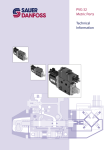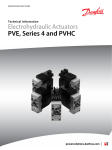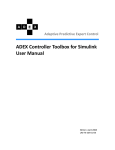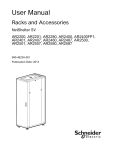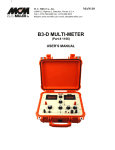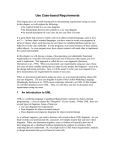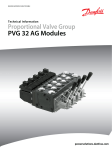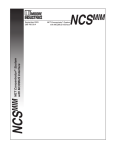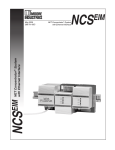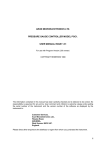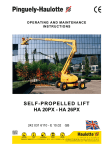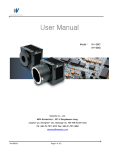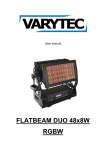Download CB2X Installation Manual RevD.indd
Transcript
Installation Manual & Technical Information Automatic Laser Control Control Box Model CB26 Model CB24+ Software Version 4.00 ATI-010864 Rev D Disclaimer All documentation, data, dimensions, and drawings in this manual were compiled and checked with great care, however Apache Technologies, Inc. cannot assume responsibility for possible errors or omissions. We reserve the right to change designs and specifications without notice. Apache Technologies, Inc. accepts no liability whatsoever for direct or indirect damage that may occur due to the unauthorized or improper use or interpretation of this document, and also shall not be held liable for direct or consequential damages resulting from improper service, application, maintenance or use of the product. This document is strictly for the use of qualified service technicians with the requisite technical skills, training, and facilities. This manual should be read completely before installing the product. Reproduction of any or all parts of this manual, including electronic, is prohibited without the written permission of the Apache Technologies, Inc. It also may not be used for any purpose other than for which it was intended, nor made accessible or communicated in any form to any third party not expressly authorized by Apache Technologies, Inc. October 2005 Apache Technologies, Inc. 8261 State Route 235 Dayton, OH 45424 USA Phone: (937) 482-0200 Fax: (937) 482-0030 Website: www.apache-laser.com Email: [email protected] TABLE OF CONTENTS T Safety ............................................................................................... 2 Pre-Installation ................................................................................. 3 General Installation .......................................................................... 3 Control Box Controls and Displays ................................................... 7 Control Box Configuration and Set Up ............................................. 9 APPENDICES A. CB26 or CB24+ Operator’s Manual .............................................. 15 B. Hydraulic Valve Guide and Valve Wiring ...................................... 16 C. Cable Diagrams ........................................................................... 19 D. LED Counter Switch .................................................................... 22 E. Operation Switches Reference Page ........................................... 23 F. Installation Switches Reference Page .......................................... 24 G. Advanced Installation Switches Reference Page ........................ 25 H. Internal Switches Reference Page .............................................. 26 I. Self Diagnosing Fault Codes ......................................................... 27 J. Valve Identification and Setting Recomendation ........................... 29 K. Miscellaneous Installation Information .......................................... 30 © Apache Technologies, Inc. 2005 All rights reserved. No part of this manual may be reproduced, or transmitted in any form or by any means, electronic, mechanical, photocopying, recording, or otherwise, without prior written permission of Apache Technologies, Inc. Automatic Control 1 SAFETY Meaning of Symbols WARNING: Indicates a potential hazardous situation, which could result in death or serious injury. CAUTION: Indicates a potentially hazardous situation, which could result in a minor or moderate injury and/or material, financial, or environmental damage. NOTE: Important information to enable the product to be used in a correct and efficient manner unrelated to safety. NOTE: The installation technician should be a qualified person who is familiar with the installation, construction, and operation of the machine and laser equipment and the hazards involved. NOTE: The user of this product is expected to follow all operating and safety instructions of this manual and of the machinery operator’s manual. Perform periodic checks of the product’s performance. The manufacturer or its representatives assume no responsibility for results of the use of this product including any direct, indirect, consequential damage, and loss of profits. Check your work frequently. WARNING: High pressure fluid is present in operational hydraulic systems. Fluids under high pressure are dangerous and can cause serious injury or death. Do not make modifications, repairs or adjustments to any hydraulic system unless you are competent or working under competent supervision. If in doubt consult a qualified technician or engineer. WARNING: When working near construction or agricultural machinery, follow all safety precautions as described in the machinery’s user manual. Familiarize yourself with all basic functions of the machine before operating or beginning any work. WARNING: Do not remove the back panel of the control box. The back panel is to be accessed by authorized Apache Technologies service personnel only. WARNING: Be aware of all overhead obstructions and electrical power lines. The receiver and mast may be higher than the machinery. Remove when transporting. WARNING: When excavating or trenching, follow all excavation and trench safety regulations and practices. CAUTION: Do not disassemble any part of the receiver other than to replace batteries. The receiver is to be serviced by authorized Apache Technologies service personnel only. CAUTION: Ensure all equipment is properly installed, the BULLSEYE receiver is secured in its mounting position, and all cables connections are tight and secure. NOTE: Environmental Limits: Suitable for use in an atmosphere appropriate for human habitation (no protection in an aggressive or explosive environment). Automatic Control 2 PRE-INSTALLATION The following should be reviewed with the owner and/or operator prior to installation: • Machines must be within the manufacturer’s specification for fine grading. Loose linkage or “slop” between the blade and lifting cylinder will adversely affect grade performance. • Similarly, uneven cutting edge wear will result in non-uniform grade surfaces. • Existing wear or damage to the machine’s hydraulic system including heat damage, oil contamination, existing leaks at fittings, hoses, valves, or cylinders and kinks or abrasion damage to hoses should be addressed. • Maintenance program or rebuild/overhaul history if the machine is an older model. GENERAL INSTALLATION System Description - CB26 Apache Automatic Blade Control is used on construction grading machinery to automatically control the blade in earthmoving and grading applications. It is also used on agricultural drainage and land leveling machinery. A single BULLSEYE laser receiver mounts above the cutting edge of the blade. The Model CB26 control box mounts in the machine's cab. A hydraulic installation kit ties into the machine’s hydraulic system. Grade information from a rotating laser is processed and automatically directs the machine’s hydraulics to maintain the elevation of the blade. The Model CB26 control box will work with many types of hydraulic valves, from on/off (bangbang) solenoid valves to fully proportional valves. The system is designed to work with a single BULLSEYE machine control receiver. The system will accept BULLSEYE models 5, 5+, 5MC, or 6. NOTE: If the BULLSEYE receiver was purchased prior to the purchase of the control box, check with the factory as updates to the receiver may be required. Please have the receiver model and serial number available. These updates are free of charge. Automatic Control 3 GENERAL INSTALLATION System Description - CB24+ The Model CB24+ control box is similar in configuration to the Model CB26 control box, but there are some differences. The Model CB24+ control box will work with only on/off (bang-bang) solenoid valves. It will not work with proportional current or proportional voltage valves. The CB24+ is designed to work with a single BULLSEYE machine control receiver. The system will accept BULLSEYE models 3+, 5+, 5MC, or 6. The valve drive selector switch (15) does not function with the CB24+. Refer to controls and configuration sections beginning on page 7. When used with the BULLSEYE 3+, the on-grade deadband is limited to 1 inch (25 mm) total. The BULLSEYE 3+ has a total of 2 inches of proportional photocells which leaves a minimum of 1/2 inch for grade corrections on each side. When combining wide deadbands and low gain settings, the valve may not reach 100% valve on duty cycle on large corrections. NOTE: The BULLSEYE 3+ is designed to work with the CB24+ control box only. NOTE: If the BULLSEYE receiver was purchased prior to the purchase of the control box, check with the factory as updates to the receiver may be required. Please have the receiver model and serial number available. These updates are free of charge. Automatic Control 4 GENERAL INSTALLATION Components Control Box The Control Box should be mounted in a location that is easily visible to the operator, is within easy reach of the operator’s hands, and can be easily installed and removed. Insure that the location does not interfere with other machine controls or operator movements. The Control Box has vented drain holes on the rear bottom of the unit that must face downward. A control box mounting bracket (ATI-950054) is designed to accept the mounting knobs that are included with the control box. BULLSEYE Receivers The BULLSEYE receivers mount to round masts from sizes 1.66” to 2.00” O.D. (42 to 50 mm) and to 1-1/2” (38 mm) square tube. The communication protocol for the BULLSEYE receivers is proprietary RS485 @ 62.5 kbaud. Masts The Model STM1 shock mounted manually telescoping mast allows the receiver to be positioned above the machinery for unobstructed laser reception. A mast mounting plate that is welded to the blade is also available. Installation instructions are provided with the mast and are also in Appendix J. Hydraulic Valve: The CB26 Control Box supports Proportional Time (PT), Proportional Current (PC), and Proportional Voltage (PV) hydraulic valves. The CB24+ Control Box supports Proportional Time (PT) valves only. For specific information on these valves, please refer to Appendix B. Hydraulic installation kits are available for several common machines. Some kits contain the hydraulic valves, valve brackets, hydraulic hoses and fittings necessary for automatic control of a specific machine. Other valve kits require some additional components to be supplied. A separate installation guide is included with the hydraulic kit. Automatic Control 5 GENERAL INSTALLATION System Wiring Cables are generally shipped at the predetermined length required for a particular machine. Connectors are installed at the factory. Plan the routing of all cables prior to actual installation. All cables should be properly installed. Cables should be attached to the machine at a minimum of every 2 to 3 feet (.6 to 1.0 meter) or less to try to eliminate cable movement and possible abrasion damage. Special care should be taken at flex points to ensure the cable moves freely and does not rub on other hoses, fittings, or the machine. Provide adequate cable length to avoid pinching, stretching, and tight bending. Also, cables should not be clamped to pipes or hoses that will cause the cable to be exposed to high temperatures. Connect the 4-socket connector on the power cable to the 4-pin connector on the box. Route the cable to the machine's battery and connect the terminal ends to the battery. The red terminal is for the positive post and the black is for ground. The box has reverse polarity protection in case the terminals are connected improperly. NOTE: In order to utilize the machine's master disconnect, the ground wire must be connected to the machine frame. Connect the 6-pin receiver cable end to the 6-socket connector on the box. Route the cable to the receiver. Connect the 7-socket receiver cable end to the 7-pin connector on the bottom of the BULLSEYE receiver. If a receiver cable with a junction block is used, follow the instructions provided with the cable. Connect the 10-pin valve cable to the 10-socket connector on the box. Route the cable to the valve and connect the open-ended wires to the valve following the directions for the valve. Cable diagrams and part numbers are in Appendix C. Optional Remote Switch The remote switch assembly is designed to mount to lever shafts from 3/8 to 1-1/8 in. (10 to 28 mm) The switch can be a single function of Auto / Manual selection or can be configured with the additional Raise / Lower function. Cable diagrams and part numbers are in Appendix C. Additional installation instructions are provided with the switch and are also in Appendix J. Automatic Control 6 CONTROL BOX - CONTROLS AND DISPLAYS Front View 3 2 4 5 1. 2. 3. 4. 5. 6. 7. 8. 9. 6 1 LED grade display Power ON / OFF push switch Power ON indicator Automatic / Manual toggle switch Automatic ON indicator Manual ON indicator Raise / Lower toggle switch Access panel thumbscrews Access panel 7 8 8 9 10 11 12 13 Operation Switches 14 15 Operation Switches: 10. Rotary switch - On-Grade Deadband selections (Default setting is "8".) 11. Dip Switch 4-way - Performance selections (Default setting is all in the OFF position.) 12. Rotary switch - Valve gain (speed) (Default setting is "8".) 16 Installation Switches: 13. Rotary switch - Valve balance (raise/lower) (Default setting is "8".) 14. Dip Switch 4-way - Valve set-up (Default setting is all in the OFF position.) 15. Dip Switch 4-way - Valve drive selector (Default setting is all in the OFF position.) Installation Switches 16. Fuse, 25 amp The 3 left side switches (10, 11, 12) are used by the operator to set operating functions. The 3 right side switches (13, 14, 15) are used during installation for specific valves and machine settings. These should not be changed by the operator. Automatic Control 7 CONTROL BOX - CONTROLS AND DISPLAYS Rear View 17 18 22 22 19 20 21 17. 18. 19. 20. 21. 22. Automatic Control 6-socket connector - laser receiver 7-socket connector - optional remote switch 10-socket connector - hydraulic valve outputs 4-pin connector - machine power input Identification / serial number label Mounting knobs for bracket 8 CONTROL BOX - CONFIGURATION Valve Selection (15) The Valve Drive Selector Dip Switch (15) is used to select the type of valve to be driven when used with the CB26 Control Box. Following are the types of valves supported: PT - Proportional Time PV - Proportional Voltage PC - Proportional Current On/off (bang-bang) valve drive Danfoss valve drive Various dither frequencies (Hz) and dither amplitudes (% of maximum correction) Additional information on the types of supported valves are in Appendix B. Reference Appendix J for a list of common valve models and their Control Box settings. NOTE: The CB24+ Control Box supports PT valves only. Switch settings are not functional. CB 26 Settings are as follows: PT PC 50 Hz, 10% PC 50 Hz, 20% PV PC 100 Hz, 10% PC 100 Hz, 20% PC 200 Hz, 10% PC 200 Hz, 20% PC 400 Hz, 10% PC 400 Hz, 20% Switch Bats in ON position Proportional Current Valves: Dither is a signal which is constantly sent to the valve that causes the spool to vibrate and stay lubricated. This reduces hysteresis and stiction. Choose a setting closest to the manufacturers recommendations. If cylinder lines or cylinder are vibrating from dither, select a higher frequency and/or lower the % amplitude. If the valve is sticking or sluggish, select a lower dither frequency and/or a higher % amplitude. If the control box power was on during valve selection, cycle the box power before proceeding. Automatic Control 9 CONTROL BOX - CONFIGURATION If auxiliary valve drivers and remote switches are desired, please consult the factory. Auxiliary valve drivers can be used via remote switches to drive other functions like scraper bowl eject, gate open and close, etc. Once the proper valve is selected, perform a system communication check. Turn the box on to confirm power. Check that the receiver is communicating properly. Check the raise/lower and auto/manual switches. Check the remote switch functions if installed. Check for proper hydraulic system operation. Ensure there are no leaks, excessive engine load or pressure relief valves continually opening. Check that all circuits function properly. NOTE: Before proceeding, warm up the hydraulic system to operating temperature. Run the machine at operating RPM for approximately 15 minutes while cycling the blade lift cylinder. Valve Set Up (14) - Set Valve Minimum Correction V The Valve Minimum Correction (VMC) is set to provide output flow as soon as a correction signal is received providing ffor optimum system performance. The edges of the valve spool have some degree of overlap with the corresponding edges of the valve body ports. This is required to prevent flow across the spool when it is in a neutral position. This spool overlap means that there will be a defined movement of the spool in the bore before flow begins to take place. This characteristic is sometimes referred to as valve “deadband”. In this text, adjusting the control box to account for this deadband and create a minimum blade velocity will be referred to as the Valve Minimum Correction (VMC) to avoid any confusion with laser system deadband or accuracy. Spool Overlap - Minimum distance to move valve for flow to begin. The VMC is adjusted by using the LED Counter Switch as described in Appendix D. Adjustment is made for both the raise minimum correction and the lower minimum correction. The VMC for PT valves is adjusted in increments of time. The VMC for PC or PV valves is a percentage of maximum valve correction. Valve Type PT PC, PV Automatic Control VMC Increment 10 ms 2% of max. 10 Adjustment Range 0 - 310 ms 0 - 62% of max. CONTROL BOX - CONFIGURATION Valve Set Up (14) - Set Valve Minimum Correction V Set the machines throttle to normal operating RPM. Place the blade approximately 1 foot (0.3 m) above the ground. No laser is required. RAISE Minimum Correction: (switch 1 in ON position) 1. Toggle raise/lower switch to raise and hold. 2. If no blade movement, release switch. If there is movement, skip to step 5. 3. Toggle automatic/manual switch once to auto to increase VMC one unit. 4. Return to step 1. 5. Observe blade speed. Goal is 0.5 inches (13 mm) per second. 6. If blade speed is too slow, continue increasing VMC and checking blade speed. If blade speed is too fast, toggle A/M switch towards manual to decrease VMC. 7. After proper VMC setting is obtained, note value. 8. Adjust DIP switch to OFF position. LOWER Minimum Correction: (switch 2 in ON position) 1. Toggle raise/lower switch to lower and hold. 2. If no blade movement, release switch. If there is movement, skip to step 5. 3. Toggle automatic/manual switch once to auto to increase VMC one unit. 4. Return to step 1. 5. Observe blade speed. Goal is 0.5 inches (13 mm) per second. 6. If blade speed is too slow, continue increasing VMC and checking blade speed. If blade speed is too fast, toggle A/M switch towards manual to decrease VMC. 7. After proper VMC setting is obtained, note value. 8. Adjust DIP switch to OFF position. Note: It is advisable to log the various settings for each particular machine. Automatic Control 11 CONTROL BOX - CONFIGURATION Set Valve Raise / Lower Balance (13) The valve raise / lower balance set-up allows adjustment to compensate for different raise /lower blade velocities due to cylinder imbalance or for different hydraulic system responses to different loads. Most mobile equipment uses double-acting hydraulic cylinders. Double-acting cylinders are also called differential cylinders because the effective area, and therefore the volume, of each end of the cylinder is different. The rod end of the cylinder has less area and volume than the cap end by the nature of the rod being present. This differential area and volume causes a different force and velocity during extension and retraction - or raising and lowering for a lift cylinder. Cap end of cylinder has greater volume and area than rod end. Set the machines throttle to normal operating RPM. Place the blade approximately 1 foot (0.3 m) above the ground. No laser is required. Adjust the valve set-up DIP switch (14) to the dynamic balance set mode. Set the valve balance rotary switch (13) to 8. Toggle the raise / lower switch to raise and hold. The blade will oscillate up and down. Observe the blade drifting up or down during oscillation. Adjust the rotary pot to minimize the drift. Clockwise - toward position F - if blade is drifting down. Counterclockwise - toward position 0 - if blade is drifting up. NOTE: Ensure valve set-up switches are in run mode (all switches down) before proceeding Automatic Control 12 CONTROL BOX - CONFIGURATION Set Performance Options and System Gain Refer to the operator's manual for setting performance options that include laser beam strike averaging, receiver LED's on or off, and control box LED's bright or dim. Generally, linear gain is selected for valves that have spools with an aggressive or exponential flow characteristics. Exponential gain is selected for valves that have spools with less aggressive or linear flow characteristics. Linear gain is the default position. Machine stability and hydraulic system reaction also influence the selection. Presetting System Gain Blade in Air Method: Ensure valve set up switches are in run mode. Set the machines throttle to normal operating RPM. Ensure the machine is on flat ground. Place the blade approximately 1 foot (0.3 m) above the ground. Set up the rotating laser at a typical working range. If a selectable rotation speed is available, set it to 600 RPM or faster. Mount the receiver in its normal operating position to receive the laser. Select an On-grade deadband (10) of approximately 1/2 of the jobsite tolerance. If working at ranges that exceed 500 feet (150 m), this may be increased to compensate for the rotating laser's beam "bounce". Select manual control (4). Raise the blade to position the receiver at the lower edge of its vertical reception range, but still receiving the beam. Select automatic control (4). The blade and receiver will move towards on-grade. Note any overshooting of On-grade. Repeat procedure for raise correction. Once again, note any overshooting of On-grade. Adjust the Valve Gain switch (12) until there is one small overshoot for a full receiver length correction in either direction. Clockwise rotation - towards F - corresponds to a faster, but less stable correction. Counterclockwise rotation - towards 0 - corresponds to a slower, but more stable correction. Set the Valve Set-up switch (14) to Run Mode after completion. A 5 second timer is also available for checking blade velocities. When set in this mode, the raise or lower switch will activate the blade for 5 seconds when the switch is held in the raise or lower position. The cylinder stroke can then be measured. Ensure proper clearance when using the timer. Automatic Control 13 CONTROL BOX - CONFIGURATION Check System Performance Set up the rotating laser at a typical working range. Select the RPM of the laser to 600 RPM or faster if available. Mount the BULLSEYE receiver to the mast of the machine in a position to receive the beam. Select an On-grade deadband less than the jobsite tolerance. Typically 1/2 the tolerance is the value used as a starting point. For example, if the jobsite tolerance is ± ½", set the On-Grade Deadband rotary switch (10) to 5. This is a deadband of ± ¼ inch or 0.50 inch total deadband. Ensure other switches are set to "Run Mode" and the other desired options. Fine tune the Valve Gain (12) while working in typical material and operating conditions. If the system is over correcting or too jumpy, decrease the gain setting. If the system is not correcting fast enough or is sluggish, increase the gain setting. Environmental factors and laser set up can also affect system performance. Follow the set up procedures for your laser. Ensure proper tripods are used for stable laser operation. Changing the laser RPM, laser strike averaging, deadband, gain type, gain setting, valve balance, or valve minimum corrections can affect system performance. System operation should be rechecked after changing any of these parameters. Automatic Control 14 APPENDIX A Control Box Operator’s Manual An operator’s manual is included as part of this installation manual. If missing, please request an additional copy. CB26 Control Box Operator’s Manual CB24+ Control Box Operator’s Manual Automatic Control 15 Part No. ATI-026012 Rev E Part No. ATI-026023 Rev C APPENDIX B Hydraulic Valve Guide PT - Proportional Time Valve: The PT valve, sometimes referred to as on/off or "bang-bang" valve is not a true proportional valve. It can only be turned on or off. The proportionality tionality is achieved by rapidly turning the valve on and off over time at varying duty rates as shown in the chart below. Gain = 1 Gain = 8 Lower Correction Gain = F On Grade Deadband Gain = F Raise Correction Gain = 8 Gain = 1 0% Valve Min. Correction 50% 100% PT Valve Signal (% On, Duty Cycle) Full machine voltage is applied to the valve to turn it on. To achieve desired flow rates at "100% on" corrections, proper sizing of the valve or a flow control device is required. Application Note: These valves as a group are least expensive, but control performance is not as smooth as with the PC or PV valves. Since this type of valve pops open or closed over time, the hoses can jump about and the rushing hydraulic fluid actually make a snapping sound, hence the name "bang bang" valve is often used. PT Valve Wiring: (P/N ATI-026040-XX) Orange White Black White/Black 1 2* Lower Raise Switched Power Load Sense Raise Coil Not Used Lower Coil GND Ground Ground 1 2* 3 or 4 Danfoss PT Amp Connector Red CB26 or CB24+ 10-Socket Connector A B C D E F G H I J Danfoss PT Hirschmann Connector Blue Green *Raise cylinder port is the port closest to black electronics module. Automatic Control 16 APPENDIX B Hydraulic Valve Guide PC - Proportional Current Valve: PC valves are proportional spool valves. Gain = 1 (Linear) Gain = 8 (Linear) Lower Correction Gain = 8 (Exponential) Gain = F (Linear) On Grade Deadband Gain = F (Linear) Raise Correction Gain = 8 (Exponential) Gain = 8 (Linear) Gain = 1 (Linear) 0% Valve Min. Correction 50% 100% PC Valve Signal (% of Maximum Current) The maximum current supplied to the valve solenoid is equal to machine voltage divided by coil resistance. Pulse Width Modulation (PWM) is used to create the < 100% proportional current signal. The PC signal energizes 1 coil at a time which slides the valve's spool back and forth changing the valve's orifice size which changes the oil flow rate. If the valve's maximum current rating is less than the maximum supplied current, (machine voltage / coil resistance), use the PC valve current set mode (Appendix G) to lower the maximum supplied current to within the valve's maximum rated current. Reference Appendix J for PC valve identification and control box settings. Application Note: PC Valves are typically fast, but not always accurate. Direct operated solenoid PC Valves are limited in flow rates to about 8 GPM (30 l/m) due to the force capability of 12V solenoids. PC Valve Wiring: (P/N ATI-026040-XX) Blue Green Red CB26 or CB24+ 10-Socket Connector Orange White Black White/Black Automatic Control A B C D E F G H I J Lower Raise Switched Power Load Sense Raise Coil Not Used Ground Ground 17 Lower Coil APPENDIX B Hydraulic Valve Guide PV - Proportional Voltage Valve: Namely, Danfoss PVG32, pilot operated proportional valves with "on-board" electronics, spool position and fault monitoring. Gain = 1 (Linear) Gain = 8 (Linear) Lower Correction Gain = 8 (Exponential) Gain = F (Linear) On Grade Deadband Raise Correction 25% 0% 50% Valve Min. Lower Correction 75% 100% Valve Min. Raise Correction PV Valve Signal (% of Machine Voltage) The PV valve signal is a low power ratiometric voltage signal that references the switched power output (machine voltage). I.e. 50% of machine voltage = No flow 25% of machine voltage = Full lower 75% of machine voltage = Full raise Danfoss diagnostics: Green LED on valve = OK Red LED on valve = Fault Application Notes: PV valves provide larger flows up to 32 GPM (120 l/m) and have more accurate flows. For best performance use PVEH actuation modules and linear spools. Valves are easily converted to interface with open center, closed center, and load sensing hydraulic systems. Raise cylinder port is the port closest to the black electronics module. PV Valve Wiring: (ATI-026040-XX) CB26 10-Socket Connector Orange White Black White/Black Automatic Control Not Used 3 1 D.F. Diagnostic Switched Power Load Sense 2 PV Signal GND Ground Ground 18 4 2 1 3 Danfoss Amp. Connector Red A B C D E F G H I J Danfoss Hirschmann Connector Blue Green APPENDIX C Cable Diagrams 7 SOC 7 PIN Automatic/Manual Raise/Lower Remote Switch Automatic/Manual Remote Switch 3 6 PIN BULLSEYE 3+, 5+, 5MC, 6 (Note: 3+ works with CB24+ only) 6 SOC 6 1 or or 7 2 6 PIN 6 SOC 7 SOC 4 PIN 10 SOC Control Box CB 26 or CB24+ 4 SOC 7 PIN 10 PIN 5 4 Master Disconnect Switch + — 10 --30V 30 VDC 10 DC PV Valve PC or PT Valve Number Part Number Description 1 ATI 024013-xx Receiver cable 2 ATI 024019-xx Receiver cable with mounting block for coil cord 3 ATI 024104 4 ATI 024012-xx Coil cord Power cable 5 ATI 026040-xx Valve cable for PT / PC / PV valves 6 ATI 026017-xx Remote switch cable - auto/manual 7 ATI 026016-xx Remote switch cable - auto/manual and raise/lower -xx reprsents cable length in feet. Note: The CB24+ Control Box works with PT valves only. Automatic Control 19 APPENDIX C Cable Diagrams Receiver Cable ATI-0240013-xx (-xx represents cable length in feet) Red - Power A Green - Comm. B White - Comm. C Black - Ground D Not Used E Not Used F Not Used G A F B G E D C F A E D B C A Red - Power B Green - Comm. C White - Comm. D Black - Ground E Not Used F Not Used A Red - Power B Green - Comm. C White - Comm. D Black - Ground E Not Used F Not Used A Red - Power B Green - Comm. C White - Comm. D Black - Ground E Not Used F Not Used A Black - Ground B White - Ground C Red - Power D Green - Power Receiver Cable with Mounting Block ATI-024019-xx Red - Power A B Green - Comm. B C White - Comm. C Black - Ground D Not Used E Not Used F A F D E F E A D B C Coil Cable ATI-024104 Red - Power A Green - Comm. B White - Comm. C Black - Ground D Not Used E F Not Used F E Not Used G A F B G E C D A D B C Power Cable ATI-024012-xx Automatic Control 20 A D B C APPENDIX C Cable Diagrams Valve Cable ATI-026040-xx (-xx represents cable length in feet) A Blue - PT/PC Lower B Green - PT/PC Raise, PV Fault C Red - Switched Power D Orange - Load Sense E White - PV Signal F G A H G I B F J C E D H I Black - Ground J White/Black - Ground Remote Switch Cable ATI-026016 (Auto/manual and raise/lower) ATI-026017 (Auto/manual only) F A E G B D C Orange A Auto / Manual Green B Raise / Lower Not Used C Aux Remote 0 Not Used D Aux Remote 1 Not Used E Red F Power Black G Ground Raise / Lower Switch Auto / Manual Switch Auto / Manual Connecting Pin A to Ground toggles control to Manual. Connecting Pin A to Power toggles to Automatic. Raise / Lower Connecting Pin B to Power creates a valve Raise signal (100%) Connecting Pin B to Ground creates a valve Lower signal (100%) Automatic Control 21 APPENDIX D LED Counter Switch The control box uses a combination of switches and LED's to provide a counter for various set up operations. The Valve Minimum Correction uses this counter for adjustment of spool overlap correction during initial set up. When the appropriate DIP switches are selected, the LED array and Auto / Manual switch on the front of the control box function together to form a binary counter. Each row of LED’s represent a specific number as follows: 16 8 4 2 1 An active LED row represents that specific number. Examples: represents 2 represents 16 Multiple rows of LED’s can be active. If multiple rows are active, the number that each row represents are added together. Examples represents 11 (1 + 2 + 8) represents 18 (2 + 16) The combinations can represent numbers from 0 to 31. The auto / manual switch is used to change the value of the LED Counter. The auto switch (up) increases the value. The manual switch (down) decreases the value. Automatic Control 22 APPENDIX E Operation Switches Reference Page On-Grade Deadband (10) Pot Deadband Value in. mm 0 0.0 0.0 1 0.1 2.5 2 0.2 5.1 3 0.3 7.6 4 0.4 10.2 5 0.5 12.7 6 0.6 15.2 7 0.7 17.8 8 0.8 20.3 9 0.9 22.9 A 1.0 25.4 B 1.1 27.9 C 1.2 30.5 D 1.3 33.0 E 1.4 35.6 F 1.5 38.1 Performance Options (11) 1 2 Strike Averaging OFF 2 Strike Averaging ON 2 Receiver LED Disable OFF Receiver LED Disable ON 3 Control Box LED’s Bright Control Box LED’s Dim 4 Exponential Gain Factory Default Setting = 8 Valve Gain (12) Distance from Deadband to Full Blade Speed Pot Linear Exponential Value mm mm 0 (slow) 200 78 1 170 71 2 148 63 3 129 57 4 112 53 5 98 47 6 86 42 7 75 37 8 65 33 9 56 28 A 48 25 B 40 21 C 33 17 D 26 14 E 19 11 F (fast) 12 8 Linear Gain Factory Default Setting = 8 Factory Default Setting = All OFF Automatic Control 23 APPENDIX F Installation Switches Reference Page Valve Balance (13) Pot Valve Set-up (14) Run Mode Value 0 Lower = 8.00 x Raise 1 Lower = 7.07 x Raise 2 Lower = 6.13 x Raise 3 Lower = 5.20 x Raise 4 Lower = 4.27 x Raise 5 Lower = 3.33 x Raise 6 Lower = 2.40 x Raise 7 Lower = 1.47 x Raise 8 Raise = 1.47 x Lower 9 Raise = 2.40 x Lower A Raise = 3.33 x Lower B Raise = 4.27 x Lower C Raise = 5.20 x Lower D Raise = 6.13 x Lower E Raise = 7.07 x Lower F Raise = 8.00 x Lower Factory Default Setting = 8 Automatic Control Raise Valve Minimum Correction Mode Drives valve at VMC value with R switch Factory Setting = 0 Lower Valve Minimum Correction Mode Drives valve at VMC value with L switch Factory Setting = 0 Dynamic Balance Set Mode Use with Valve Balance Switch (13) Oscillates blade with raise or lower switch 5 Sec. Timer If sustained R or L, will time out after 5 sec. Valve Drive Selection (15) (CB 26 Only) PT PV Factory Default Setting PC 50 Hz, 10% PC 100 Hz, 10% PC 200 Hz, 10% PC 400 Hz, 10% PC 50 Hz, 20% PC 100 Hz, 20% PC 200 Hz, 20% PC 400 Hz, 20% Factory Default Setting = All OFF 24 APPENDIX G Advanced Installation Switches Reference Page Valve Set-up (14) NOTE: The advanced installation switches are used for special applications and circumstances. In general, default settings for the functions below will suffice for most applications. Value for the following functions are adjusted with the LED counter switch as described in Appendix D. Load Sense Set Mode 0 = Load Sense OFF 1 = Load Sense ON Factory setting = 0 (Software version 4.0 and later) Switched Power Mode for PT / PC Valves. (Switched power is always on for PV valves.) 0 = Switched power OFF 1 = Switched power ON Factory setting = 0 (Software version 4.0 and later) Display Averaging Set Mode - Uses strike averaging to smooth LED display. Takes into account laser RPM. 0 = Adaptive 1 = 1 strike 2 = 9 strike weighted average 3 = 13 strike weighted average Factory setting = 0 Maximum Valve Current Set Mode Limits pulse width modulation (PWM) which limits current sent to PC & PT valves at maximum correction. 0 = 100% maximum PWM = full current 1 – 25 = 96% – 0% of full current Factory setting = 0 PC Valves: Included with S/N 0201 and higher (Software Version 3.0 and later). PT Valves: Included with Software Version 4.0 and later Control Deadband Set Mode - Determines if the corrections drive to the edges or inside the deadband. 0 = Corrections per on-grade deadband switch (10) setting. 1 = Inward corrections stop @1/2 on-grade deadband setting, outward corrections start @ on-grade deadband setting. 2 = Inward corrections start and outward corrections stop @ 1/2 on-grade deadband setting. Factory setting = 0 Automatic Control 25 APPENDIX H Internal Switches Reference Page The main circuit board inside the control box has two additional 4-way dip switches. Switch 101 functions are described below. Switch 100 is used for auxiliary valve configurations and other test simulations. SW100 SW101 (Factory Settings) (Factory Settings) 1 Manual Raise/Lower Override in Auto OFF Manual Raise/Lower Override in Auto ON 2 False Strike Rejection Disabled False Strike Rejection Enabled 3 Manual R/L Ramp OFF Manual R/L Ramp ON Default ON position allows the manual raise switch to send the raise signal to the valve even when in the automatic mode. Default ON position filters out signals that are out of time with laser, strike multiple channels at the same time (strobes), or are at an unrealistic vertical distance from the previous strike. Default ON position allows a progressive increase for the valve to get to the 100% open state in the first second. 4 Test Mode Operating Mode Automatic Control 26 APPENDIX I Self Diagnosing Fault Codes When the Control Box recognizes a fault, all receiver LED's will light solid and the Power, Auto and Manual LED’s on the control box will alternately blink. A specific fault information number will be displayed on the LED counter as described in Appendix D. 1. Switched Power Driver Description: Over current (>5A) Location: Connector – 10 socket Pin – C Notes: Driver will shut off for 250ms. It will then retry. If 3 failed tries in 2 seconds, driver stays off until power is cycled. Possible External Causes: Short in cable coil or connectors. 2. Load Sense Driver Description: Over current (>5A) Location: Connector – 10 socket Pin – D Notes: Driver will shut off for 250ms. It will then retry. If 3 failed tries in 2 seconds, driver stays off until power is cycled. Possible External Causes: Short in cable coil or connectors. 3. Auxiliary Driver 2 Description: Over current (>5A) Location: Connector – 10 socket Pin – F Notes: Driver will shut off for 250ms. It will then retry. If 3 failed tries in 2 seconds, driver stays off until power is cycled. Possible External Causes: Short in cable coil or connectors. 4. Auxiliary Driver 3 Description: Over current (>5A) Location: Connector – 10 socket Pin – G Notes: Driver will shut off for 250ms. It will then retry. If 3 failed tries in 2 seconds, driver stays off until power is cycled. Possible External Causes: Short in cable coil or connectors. 5. Raise Proportional Current (PC) & Proportional Time (PT) Driver Description: Over current (>5A) Location: Connector – 10 socket Pin – B Notes: Driver will shut off for 250ms. It will then retry. If 3 failed tries in 2 seconds, driver stays off until power is cycled. Possible External Causes: Short in cable coil or connectors. 6. Lower Proportional Current (PC) & Proportional Time (PT) Driver Description: Over current (>5A) Location: Connector – 10 socket Pin – A Notes: Driver will shut off for 250ms. It will then retry. If 3 failed tries in 2 seconds, driver stays off until power is cycled. Possible External Causes: Short in cable coil or connectors. Automatic Control 27 APPENDIX I Self Diagnosing Fault Codes 7. Proportional Voltage Diagnostics Description: Danfoss Passive or Active fault monitoring Location: Connector – 10 socket Pin – B Notes: Passive Danfoss - Fault will clear when fault removed. Active Danfoss - Fault will clear when fault removed and power cycled. Possible External Causes: PV signal exceeds 15% - 85% of supply, LVDT wires broken or shorted, Spool position exceeds command. 9. Proportional Voltage Driver Description: Over current (>0.06 A) Location: Connector – 10 socket Pin – E Notes: Driver shuts off during fault. Fault will clear when fault removed Possible External Causes: Short in coil cables or connectors. 15. Remote Switch Driver Description: Over current Location: Connector – 7 socket Pin – F Notes: Fault will clear when fault removed Possible External Causes: Short in cables or connectors. 16. Receiver Communication Description: Loss of communication Location: Connector – 6 socket Pin – A,B,C,D Notes: Fault will clear when receiver communicates with the control box Possible External Causes: Loss of power to receiver, loss of communication with receiver. 18. Machine Low Voltage Description: Machine Power < 9.5V Location: Connector – 4 pin Pin – A,B,C,D Notes: Fault will clear when voltage returns to operating range. Possible External Causes: Low battery, voltage regulator, poor connections, undersized / over length conductors. 19. Machine High Voltage Description: Machine Power > 31.5V Location: Connector – 4 pin Pin – A,B,C,D Notes: Fault will clear when voltage returns to operating range. If sustained, fuse will blow. Possible External Causes: Voltage regulator, alternator, power spikes. 20. Internal Problems Description: Control Box Proc/Ram Check Location: Connector – N/A Pin – N/A Notes: Cycle control box power to clear fault. If fault doesn’t clear, control box needs serviced. Possible External Causes: Processor or RAM problems. Automatic Control 28 APPENDIX J Valve Identification and Setting Recomendation Valve Identification Mfgr. Model Number Solenoid CB26 Setting Recommendations Solenoid Description ID Drive Dither Dither Current Type Freq. Ampl. Limit (Hz.) (%) (LCS) Danfoss PVG32 with PVEH elect. Module 157B4016 12VDC, Active Fault, Hrshmn conn. PV N/A N/A N/A Danfoss PVG32 with PVEH elect. Module 157B4028 24VDC, Active Fault, Hrshmn conn PV N/A N/A N/A Danfoss PVG32 with PVEH elect. Module 157B4086 12VDC, Passive Fault, Hrshmn conn. PV N/A N/A N/A Danfoss PVG32 with PVEH elect. Module 157B4088 24VDC, Passive Fault, Hrshmn conn. PV N/A N/A N/A Danfoss PVG32 with PVEH elect. Module 157B4032 11-32VDC, Active Fault, Hrshmn conn. PV N/A N/A N/A Danfoss PVG32 with PVEH elect. Module 157B4033 11-32VDC, Passive fault, Hrshmn conn. PV N/A N/A N/A Danfoss PVG32 with PVEH elect. Module 157B4034 11-32VDC, passive Fault, Amp conn. PV N/A N/A N/A Danfoss PVG32 with PVEH elect. Module 157B4035 11-32VDC, Active Fault, Amp conn. PV N/A N/A N/A Vickers/Eaton KDG4-3S….. GP 12VDC, 4.9 Ohms PC 100 20% 0 Vickers/Eaton KDG4-3S….. HA 24VDC, 19.6 Ohms PC 100 20% 0 Vickers/Eaton KDG4-3S….. G 12VDC, 1.8 Ohms PC 100 20% 12 Vickers/Eaton KDG4-3S….. H 24VDC, 7.3 Ohms PC 100 20% 12 Nachi ESD…… 24VDC, 20 Ohms PC 100 20% 0 Parker D1FW…. K 12VDC, 6 Ohms PC 100 20% 0 Parker D1FW…. J 24VDC, 24 Ohms PC 100 20% 0 Parker D3FW…. K 12VDC, 4 Ohms PC 100 20% 0 Rexroth 4 WRAB6….. G12 12VDC, 4.8 Ohms PC 200 20% 0 Rexroth 4 WRAB6….. G24 24VDC, 19.2 Ohms PC 200 20% 0 Bosch 0811-404 …. 12VDC, 3.0 Ohms PC 200 20% 9 Bosch 0811-404 …. 24VDC, 3.0 Ohms PC 200 20% 17 Danfoss PVG32 with PVEO elect. module 157B4216 12VDC, Hrshmn conn. PT N/A N/A N/A Danfoss PVG32 with PVEO elect. module 157B4228 24VDC, Hrshmn conn. PT N/A N/A N/A Danfoss PVG32 with PVEO elect. module 157B4901 12VDC, Amp conn. PT N/A N/A N/A Danfoss PVG32 with PVEO elect. module 157B4902 24VDC, Amp conn. PT N/A N/A N/A Vickers/Eaton DG4V-3….. GH 12VDC, 3.8 Ohms PT N/A N/A N/A Vickers/Eaton DG4V-3….. HH 24VDC, 15.9 Ohms PT N/A N/A N/A Nachi SS-G0….. D1 12VDC, 4.8 Ohms PT N/A N/A N/A Nachi SS-G0….. D2 24VDC, 19.2 Ohms PT N/A N/A N/A Parker D3W…. K 12VDC, 4 Ohms PT N/A N/A N/A Parker D3W…. J 24VDC, 16 Ohms PT N/A N/A N/A Parker BV06….. D012 12VDC, 5 Ohms PT N/A N/A N/A Parker BV06….. D024 24VDC, 20Ohms PT N/A N/A N/A Parker D1VW….. K 30 watt 12VDC, 4.3 Ohms PT N/A N/A N/A Parker D1VW….. J 30 watt 24VDC, 17.3 Ohms PT N/A N/A N/A Bosch/Rexroth 4WE6….., 4WE10…. G24 24VDC, 19.2 Ohms PT N/A N/A N/A Bosch/Rexroth 4WE6….., 4WE10…. G12 12VDC, 4.8 Ohms PT N/A N/A N/A Continental VSD03M….. 42L, 70L 24VDC, 24 Ohms PT N/A N/A N/A Continental VSD03M….. 44L, 75L 12VDC, 6 Ohms PT N/A N/A N/A Automatic Control 29 APPENDIX K Miscellaneous Installation Information Remote Switch Installation Notes: 1. The Remote Switch Assembly is designed to mount to lever shafts from 3/8" to 1-1/8" in diameter by using the different screws provided. 2. Determine Remote Switch mounting location for easy access during operation. Cable should route downward from switch housing. 3. If mounted to a moving lever, ensure there is enough cable to permit full lever travel. 4. Remove any dirt or oils from the area where the switch will mount with isopropyl alcohol or detergent cleaner. 5 Remove the adhesive liners on the double sticky tape and apply the switch. 6 Select the correct length of screw for the shaft diameter and tighten clamping screws. Do not overtighten as this can distort housing and clamp. 7 Strain relief the cable by tie wrapping it to the lever as shown. 8. Check the function with the control box. Switch Orientation View Receiver Cable with Mounting Block Installation Notes: Mounting Options For ATI-024019-XX Grill Mounting JD 450-650H Dozers 1 2. Automatic Control Notch top fin for strain relief clearance & mount to grill. Leave service loop for opening grill. Grill Mounting CAT D3-D5G Dozers - Loosen top radiator mounts to provide clearance for cable connector routing past radiator. 30 Hood Mounting - If no access for cable around radiator, lay block on its side & mount to top of hood. APPENDIX K Miscellaneous Installation Information STM1 Telescoping Manual Mast Installation Notes: 1. Observe all safety practices recommenced by the machinery manufacturer while installing and using the mast. a) Turn off engine and engage parking brake. b) Rest blade on the ground. c) Take precautions to avoid lifting or falling injuries. Mast weight is 57 Lbs. (26 kg.) To minimize elevation errors due to changing cut depths: a) The mast should be positioned to place the laser receiver as close as possible vertically over the cutting edge of the blade. b) The mast should be vertical "front-to-back" when the blade is in its normal operating position. 2 To minimize elevation errors due to changing blade tilt on single laser receiver systems: a) The mast should be mounted near the center of the blade. b) The mast should be vertical "side-to-side" when the blade is in its normal operating position. 3 Weld the optional mast mounting plate (ATI-010766) to best meet the above recommendations, and: a) Not interfere with blade movement or linkages. b) Provide clearance for pin removal, or other service requirements. c) Follow all machine manufacturer precautions for welding to the machine. d) Several pieces of material are usually required to stand the plate slightly above a dozer blade. These pieces are not included with the mounting plate. 4 5 6 7 Attach the mast to the mounting plate with provided (1) 3/410 x 2-1/2 inch long grade 8 screw and lockwasher. Torque to 265 ft-lbs. (37 mkg) Attach the laser receiver to the mast as shown. Wrap the electrical cable around the mast to keep it out of harm from blade linkages or material near the blade. Attach the cable to the laser receiver. Loosen the mast clamp and extend the mast to the desired elevation to clear obstructions such as the machines cab. Tighten the mast clamp. a) Pull out on the clamp handle to reposition the handle. Automatic Control 31

































